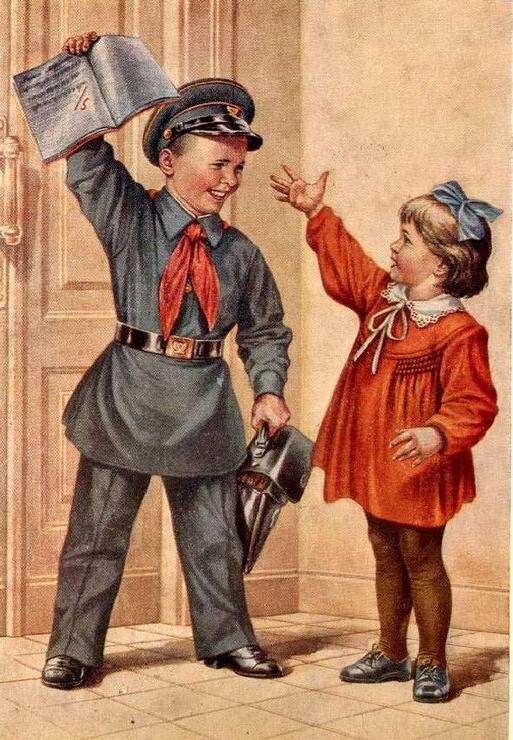
Soviet Stalinist Era Schools: Levels

Figure 1.--Here we see a Soviet postcard from the 1950s. It shows the boys' school uniform at the time. It is a tunic-styled i=uniform. We have not yet found photogrphs with boys wearing this uniform. Also notice that it is in Rd rmy green. They boy is showing off his school diary with a "5" mark--meaning an "A" in American schools. Notice the satchel. Many Soviet school children had satchels like that. His little sister who has not yet begun school seems duly impressed.
|
|
We do yet not have much information about education Soviet education during the early Stalinist era. We do know that the Soviets very substantially expanded the educational system. Education including secondary and university-level studies was opened up to Soviet children of very modest means. We also note Kindergartens in the 1930s. This appears to have been a Soviet innovation, of course imported from Germany. We are not sure if Kindergartens exisited before the Revolutuion, if they did almost certainly they were for affluent families. We are not sure how common Kindergartens were during the Soviet era. There appears to have been formal school uniform, although we are not sure about the different styles and when they were introduced. Most of our images come from after the War. A problem was that before the War because of very low-living standards may not have afforded uniforms, especially in rural areas. We note a military-looking uniform after World War II consisting of a peaked cap, tunic, wide belts, and red scarf. Younger boys might wear short pants, sometimes with over-the-knee stockings. This uniform persisted even after Stalin's death in 1953. Before the Revolution, few working-class children attended secondary schools or uni\versities. The education of girls was also significantly expanded. The uniforms in secondary schools seem the same as the primary uniforms. Our information, however is still very limited.
Pre-school
We do not notice pre-schools in Russia before the Revolution. Our archive is limited, but we think it is safe to say that if they existed that they were not very common. We are not sure if Kindergartens exisited before the Revolutuion, if they did almost certainly they were for affluent families. We note Kindergartens in the 1930s. This appears to have been a Soviet innovation, of course imported from Germany. We are not sure how common nursery schools Kindergartens were during the Soviet era. As many women worked, pres-schools were set up to care fir the younger children while mother worked.
Primary schools were already well established during the Tsarist era. There was, however, considerable illiteracy. And working-class children, especially in rural aeas might only attend for a one or two years. This changed with the Revolution. The primary system was significantly expabded during the early Soviet children. Considerable resources were devoted to the effort. The primary limitation was funancing, but by the time of World War II, most Soviet children were completing primary programs. There appears to have been formal school uniform, although we are not sure about the different styles and when they were introduced. Most of our images come from after the War. A problem was that before the War because of very low-living standards may not have afforded uniforms, especially in rural areas. We note a military-looking uniform after World War II consisting of a peaked cap, tunic, wide belts, and red scarf. It is not ckear how many schools actually had this uniform. It appears to be more of an ideal, than a commonly worn uniform, especially in the early-50s. Younger boys might wear short pants, sometimes with over-the-knee stockings. This uniform persisted even after Stalin's death in 1953.
Secondary Schools
It was the secondary anbd university education systems that the Soviets most significantly expanded. Before the Revolution, few working-class children attended secondary schools or universities. The education of girls was also very limited. This changed with the Revolution. It could not be expnded as rapidly as the primary system as you needed large numbers of students in the upper primary years to input into new secondry school. There was, hiwever, a very rapid expansion of the system. By the time of World War II, large numbers of students were in the secindary system. We do not have actual numbers, but believe it was comparable to Western urope and more comprhensive than in many European countries. The uniforms in secondary schools seem the same as the primary uniforms. Our information, however is still very limited.
HBC-SU

Related Chronolgy Pages in the Boys' Historical Web Site
[Main Chronology Page]
[The 1900s]
[The 1910s]
[The 1920s]
[The 1930s]
[The 1940s]
[The 1950s]
[The 1960s]
[The 1970s]
Navigate the Relate Boys Historical Clothing Style Pages
[Return to the Main country page]
[Return to the Main Russian page]
[Long pants suits]
[Short pants suits]
[Lederhosen]
[Kneesocks]
[Eton suits]
[Jacket and trousers]
[Blazer
[School sandals]
Navigate the HBC Country School Pages
[Return to the Main Soviet Stalinist era page]
[Return to the Main Soviet school page]
[Return to the Main School Uniform Page]
[Return to the Main National School Uniform Page]
[Australia]
[England]
[France]
[Germany]
[Ireland]
[Italy]
[Japan]
[New Zealand]
[The Philippines]
[Poland]
[Scotland]
[South Africa]
[United States]
Navigate the HBC School Section:
[About Us]
[Activities]
[Chronology]
[Clothing styles]
[Countries]
[Debate]
[Economics]
[Garment]
[Gender]
[Hair]
[History]
[Home trends]
[Literary characters]
[School types]
[Significance]
[Transport and travel
[Uniform regulations]
[Year level]
[Other topics]
[Images]
[Links]
[Registration]
[Tools]
[Return to the Historic Boys' School Home]
Created: 9:46 AM 10/16/2010
Last updated: 9:46 AM 10/16/2010




